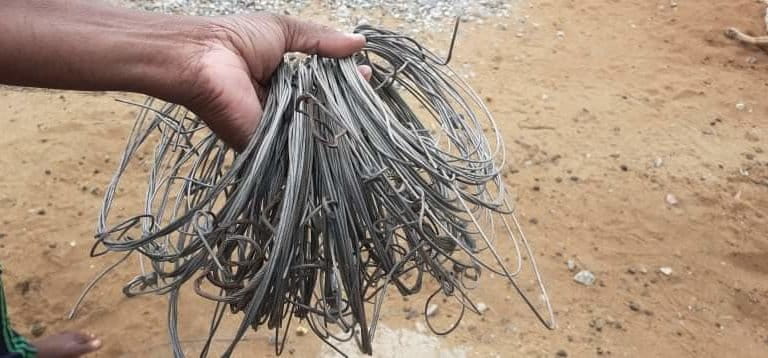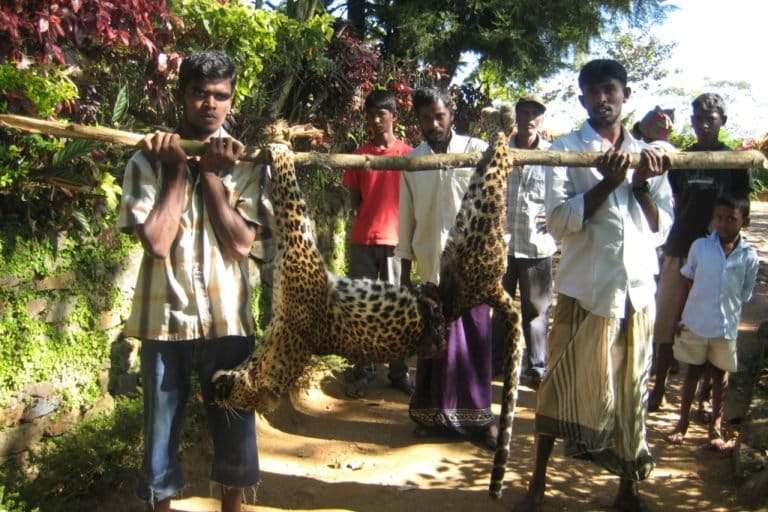- Snares are the leading cause of death among Sri Lanka’s leopards, accounting for 42 recorded deaths in the past 10 years.
- The most recent death was of a rare black leopard, which succumbed to its injuries three days after getting snared, prompting public outrage over the use of snares.
- Snares are technically banned in Sri Lanka, but an exception is allowed for trapping “pest species” such as wild boars; however, the indiscriminate nature of the devices means that all wildlife are potential targets.
- A local environmental organization has declared May 29 Leopard Day in Sri Lanka to highlight the importance of protecting the fast-vanishing iconic species and to raise awareness against existing and potential threats to the big cats.
COLOMBO — On May 29, a vanishingly rare black leopard — an actual black panther — died at a government wildlife treatment facility in Sri Lanka. It had been brought there three days earlier after being trapped in a snare in a tea estate in the hill town of Hatton, in the central district of Nuwara Eliya district. The big cat’s fate sparked public outrage in Sri Lanka, a biodiversity hotspot with a fast-dwindling population of leopards.
The Sri Lankan leopard (Panthera pardus kotiya) is a subspecies unique to the country, and also the island’s apex predator.
Typically rusty yellow in color with dark spots, leopards sometimes come in an all-black hue caused by the mutation known as melanism. That was the case with this latest leopard, which was discovered on camera trap last October, generating waves of excitement among wildlife enthusiasts at the time.

Black leopards are a rarity in Sri Lanka; this was only the third one recorded in the past decade. Far more common is the killing of wildlife by snares, typically set to trap deer or wild boar for bushmeat. The two earlier recorded black leopards were also killed in snares, in 2009 and 2013, in southern Sri Lanka on the border of the Sinharaja Forest Reserve, a UNESCO World Heritage site.
And it’s not just black leopards: snares are the primary cause of death for Sri Lanka’s leopards at large. In the first five months of this year, six leopards were caught in snares; four of them died. In the second half of May, two leopards were found in snares, one of them the black leopard. The other survived.
According to the Wilderness & Wildlife Conservation Trust (WWCT), 47 leopards were trapped in snares during the past decade. Of the total 79 leopard deaths reported during this period, 42 deaths were caused by snare-induced injuries.
“It is probable that more animals are being caught by snares and just go unreported. So the number could be much higher than this,” Andrew Kittle, a biologist with the WWCT, told Mongabay.

A snare, at its most basic, is a noose of steel wire that is concealed along trails frequented by wild animals. When the unsuspecting animal or one its limbs touches the wire, it springs the noose. As the animal struggles to free itself, the trap only gets tighter. Snaring of wildlife is outlawed under Sri Lanka’s Flora and Fauna Protection Ordinance, but an exception is made for “pest species” such as wild boars that damage crops. As events have shown, that hasn’t stopped leopards and other wildlife from getting trapped in these snares.
“The struggle to break free makes the internal organs to get damaged, making it very difficult to save these animals,” Tharaka Prasad, a veterinary surgeon and director of wildlife health with the Department of Wildlife Conservation (DWC), told Mongabay.
In the case of leopards, the snares usually catch around the animal’s hip area, where organs like the kidneys can become damaged as the noose crushes them. WWCT’s data for 2010-2020 show that 90% of leopards that get caught in snares die.

Of the 47 leopards the WWCT recorded as being snared, 37 were in the Central Highlands of Sri Lanka. “A century ago, large swaths of montane forests in the island’s central hills were cleared for tea cultivation. This left fragmented small forest patches for the leopards and these spots continue to shrink,” said Anjali Watson, an ecologist with the WWCT. “As leopards come out at night [and] frequently cross these habitats across various corridors, [that] makes them vulnerable to snare traps.”
She cited the latest case of the leopard snared in the tea estate in Hatton, the country’s tea-growing capital, noting that the area is “a typical corridor used by the hill country male leopard to cross to different forested areas.” Watson said the vegetable plot the leopard was crossing at the time was a new one that was set up by clearing an overgrown area. Conserving such corridors between tea estates that link fragmented forest habitats is something the WWCT advocates to minimize the problem.
But a nationwide lockdown imposed in response to the COVID-19 pandemic may have exacerbated the issue, Watson suggested. With many people losing work as a result of the lockdown, she said, they would have explored alternatives such as cultivating vegetable plots by clearing little corridors that are essentially paths used by wildlife such as leopards to cross, setting up snares either to protect their plots or to catch wild game.

Need for rapid rescues
The fact that snaring is technically banned in Sri Lanka yet continues unabated thanks to the “pest species” exception, needs to be addressed, conservationists say.
“Sri Lankan law has sufficient provisions to take legal action against those who set snares, on the basis that it kills indiscriminately other than the targeted wild boar,” Jagath Gunwawardana, a leading environment lawyer, told Mongabay.
“We need stringent punishments for those who set snares; perhaps jail terms and confiscation of their properties,” said Rukshan Jayewardene, a conservationist with the Leopard Trust. “This illegal practice has been ignored much too long. Wire snares kill animals indiscriminately, bringing much suffering to victims and cause lingering deaths.”
Jayewardene said it’s important to investigate whether the snares are set up in an organized manner targeting leopards.
If a leopard gets trapped in a snare at night, it may take until the afternoon of the next day for a DWC veterinary team to reach it. In those hours of struggling, the leopard would be drained of energy and suffer serious damage to its internal organs.

“With each second that’s lost to carrying out a timely rescue operation, the chances of the animal’s survival declines, so time is of great essence,” Jayewardene told Mongabay.
He called for a fully equipped wildlife rescue and treatment center to be established in the Central Highlands region to cut down on the response time. Jayewardene also stressed the importance of setting up protocols to be followed in dealing with wildlife emergencies, including the rescue and treatment of snared leopards, to ensure swift coordination among different agencies and mobilize resources in a timely manner.
“It’s not about response but rapid response. There is no time to be lost,” he said.
The public outrage sparked by the black leopard’s death is now being channeled into an awareness campaign. The Wildlife and Nature Protection Society (WNPS), a leading conservation group, has declared May 29 as Leopard Day to draw attention to the urgent need to protect Sri Lanka’s iconic apex predator and to lead the fight against the deadly snares.
Banner image of a leopard cub, the apex predator species in Sri Lanka, courtesy of Erich Joseph.
